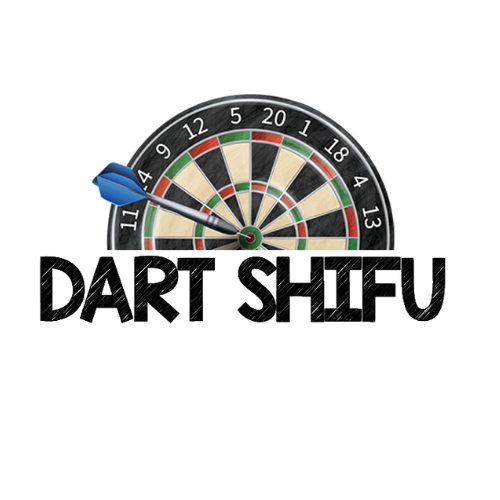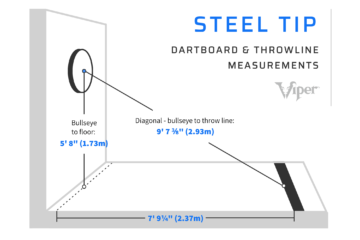Players have the option to switch darts during a game, with a limit of three changes allowed under specific circumstances. Valid reasons for dart changes include replacing damaged equipment, making adjustments due to discomfort or pain while using a particular set, or choosing the appropriate dart for a specific throw.
Changing darts can help improve accuracy and overall performance on the dartboard. The ability to adjust and switch darts during a game is a common practice among dart players, allowing them to tailor their equipment to their individual needs and preferences.
Whether it’s a matter of grip, weight, or flight, having the option to change darts during a game can make a significant difference in a player’s performance and strategy. It offers players the flexibility to adapt and fine-tune their approach, ultimately enhancing the competitive experience and gameplay.

Credit: www.ebay.com
Understanding The Rules Of Dart Game
Playing darts is not just about throwing the darts at the board; it also involves following the rules and regulations that guide the game. One of the common questions that arise is whether you can change darts during a game. Let’s delve into the rules and regulations of dart games to find out more.
Different Dart Game Formats
There are various formats of dart games, each with its own specific rules. Some popular formats of dart games include:
- 501: Players start with a score of 501 and must reduce it to zero through precise throwing and calculation.
- Cricket: In this format, players aim to “close” certain numbers and score points while preventing their opponent from doing the same.
- Killer: A multiplayer game where all players aim to knock each other out by hitting specific numbers on the dartboard.
Regulations On Equipment Usage
When it comes to changing darts during a game, it’s essential to understand the regulations regarding equipment usage. The following are some general rules relating to darts and equipment in most standard dart games:
- Once the game has begun, players typically cannot change their darts until the game is completed. This ensures fairness and consistency throughout the game.
- Players are often required to use darts that meet specific weight and length requirements set by the organizing body or the game format being played.
- In team competitions, the regulations may specify whether teammates are allowed to share darts during the game.
Impact Of Switching Darts Mid-game
When it comes to the game of darts, the question of whether it’s acceptable to change darts mid-game often arises. Players may wonder about the impact of switching darts mid-game and whether it’s within fair play guidelines. Let’s examine how changing darts influences performance and the considerations related to fair play when it comes to this practice.
What is the allowed frequency for changing darts during a game?
Given the allowance for changing darts during a game, it’s important to note that, as per the Darts Regulation Authority Rule Book, players are permitted to utilize up to three different dart sets throughout a game. Before the commencement of the game, players must inform the tournament director or referee of their intention to switch darts. While there’s a general guideline of a five-minute window for dart changes or repairs, the actual timeframe is typically at the discretion of the tournament director or referee.
It’s crucial to execute the change of dart sets swiftly and professionally within the designated timeframe. Players who exceed the allowed time for throwing the next dart may encounter restlessness from the crowd.
Additionally, adherence to the specific rules of both the organization and the governing body in your state or country is essential. Different dart rules may apply to players representing various countries, such as variations between American and British tournaments.
How Changing Darts Influences Performance
The decision to change darts during a game can significantly impact a player’s performance. The weight, balance, and grip of a dart can vary between sets, which can affect a player’s accuracy and consistency. Even subtle differences in darts can lead to a need for players to adjust their throwing technique, potentially disrupting their rhythm and focus.
Furthermore, the muscle memory developed by using a specific set of darts can be disrupted by switching to a different set mid-game, potentially leading to decreased accuracy and performance. Players must consider these aspects before deciding to change darts during a game, as it can have a notable impact on their overall performance.
Adhering To Fair Play Guidelines
From a fair play perspective, changing darts mid-game raises important considerations. In a competitive setting, players need to adhere to the rules and ethics of the game. While there may not be explicit rules prohibiting the changing of darts during a game in some informal settings, players need to maintain sportsmanship and fair play.
Changing darts can potentially disrupt the flow of the game and may be considered as an attempt to gain an unfair advantage, particularly if done strategically to unsettle an opponent. Players must consider the impact of their actions on the fairness and integrity of the game, ensuring that they uphold the principles of fair play when considering whether to switch darts during a game.
Benefits Of Consistency In Dart Selection
When playing darts, consistency in dart selection can greatly impact your performance. Maintaining consistency in the type of darts you use offers several benefits that can enhance your gameplay and improve your overall accuracy.
Maintaining Control And Precision
Consistently using the same type of darts throughout a game allows you to maintain control and precision. When you’re familiar with the weight, shape, and feel of your darts, you’re better able to execute your throwing technique consistently. This enhanced control directly translates to improved precision in hitting your target on the dartboard.
Improving Muscle Memory
Another significant benefit of consistent dart selection is the improvement of muscle memory. By repeatedly using the same darts, your muscles become accustomed to the specific throw required for those darts. This repetitive practice strengthens your muscle memory, making it easier to reproduce your throwing technique with accuracy and consistency each time you throw.
Tips For Managing Dart Selection During Play
Choosing the right darts and managing their selection during a game can significantly impact your performance on the dartboard. Can you change darts during a game? The short answer is yes, but it’s crucial to do so strategically and with consideration for the playing conditions. Here are some essential tips for effectively managing dart selection during play.
Assessing Conditions And Adjusting Strategy
When you find yourself struggling with your current set of darts during a game, it’s essential to quickly assess the conditions and make necessary adjustments to your strategy. Factors such as the airflow in the playing area, the condition of the dartboard, and your own physical and mental state can all influence your dart performance. Being able to adapt and make informed decisions about changing your darts based on these conditions is key to maintaining your competitive edge.
Utilizing Backup Darts Effectively
Having backup darts at your disposal can be a game-changer when it comes to dart selection during play. While your primary set of darts may be well-suited for most scenarios, there may come a time when switching to backup darts becomes necessary. It’s important to regularly practice with your backup darts to ensure that you are comfortable and familiar with their feel and performance. When the time comes to make a change during a game, having confidence in your backup darts can provide the advantage you need to turn the tide in your favor.
Professional Insights On Changing Darts Mid-game
Changing darts mid-game is often a topic of debate among professional players and enthusiasts. While some believe that sticking with the same set of darts throughout a match is crucial for consistency, others argue that switching to a different set can be a strategic move. Let’s explore some professional insights on the topic to shed light on whether changing darts during a game is a viable option for players seeking an edge.
Strategies For Adapting To Unforeseen Circumstances
Professional dart players often encounter unforeseen circumstances during a match, such as a change in air flow, lighting, or even psychological factors. Adapting to these changes is a crucial aspect of the game, and for some players, this may involve changing darts mid-game. By having multiple sets of darts and adapting to different conditions, players can maintain their performance levels even in challenging situations.
Adapting To Equipment Limitations
When it comes to dart equipment, limitations can arise, such as a dart becoming damaged or the need to adjust to a different board. In such scenarios, changing darts mid-game can be a practical solution. Professional players often carry a range of darts with different weights and grip styles to adapt to various conditions and equipment limitations, allowing them to maintain their accuracy and performance without being hindered by equipment issues.
Wrapping Up
Changing darts during a game can affect your performance and rhythm. It’s important to practice with different darts for adaptability. Understanding the rules and regulations of the game is crucial. Ultimately, consistency and comfort with your equipment are key to achieving success in darts.
FAQs
Can I Change Darts During A Game?
Yes, you can change darts between turns in a game. It’s common to switch darts based on different throwing styles, distances, or target areas.
Is It Legal To Change Darts During A Match?
Yes, it’s legal to change darts during a match. Players often switch between darts to adapt to specific game situations or to find the best fit for their throwing style.
How Often Can I Change My Darts?
You can change your darts as often as you like during a game. There are no restrictions on the number of times you can switch darts while playing.
What Are The Best Times To Change Darts?
You can change darts between turns or while taking a break. It’s important to find the right dart for each throw to improve your game.

